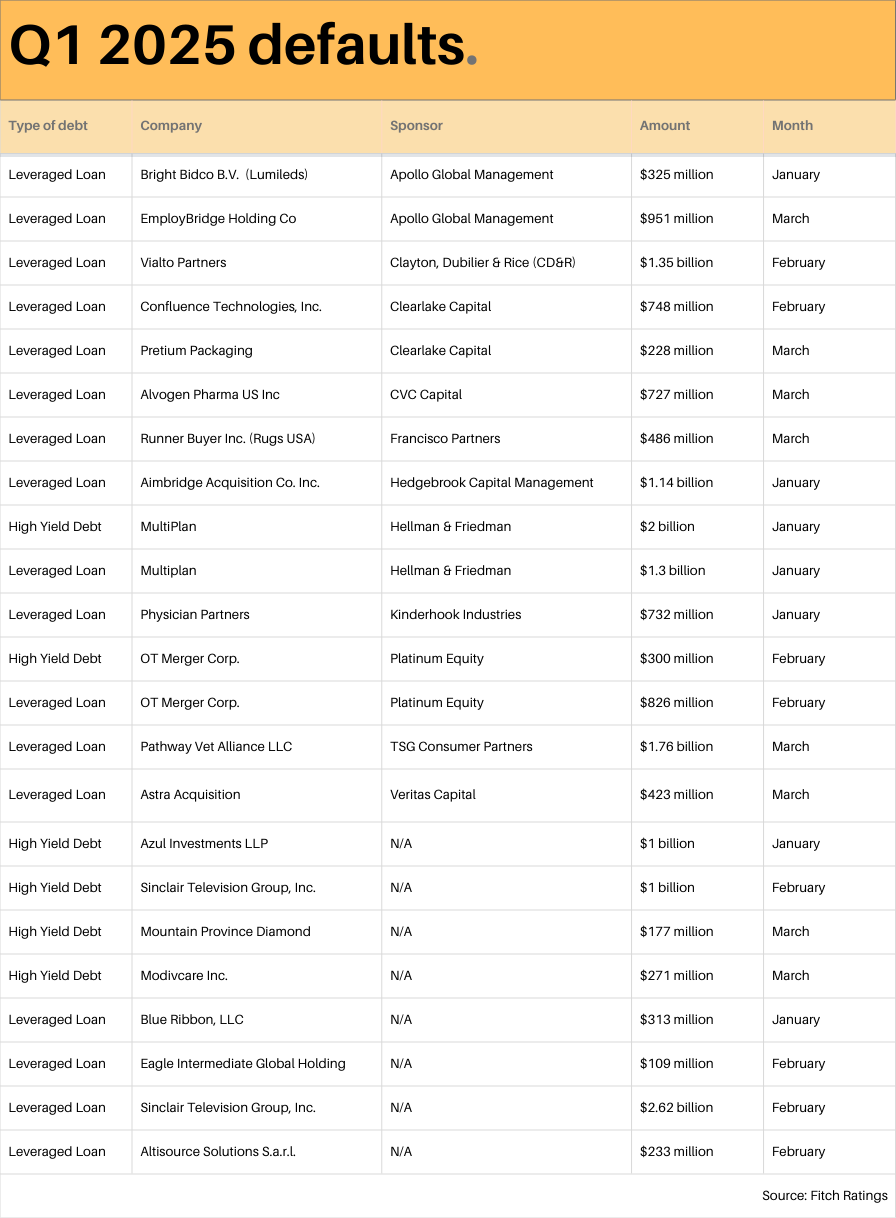PE-Backed Companies Dominated Q1 2025 Debt Defaults
According to Fitch Ratings, 15 of the 23 leveraged loan and high yield debt defaults in Q1 were by private equity-owned companies. Portcos also dominated large bankruptcies.
Critics of over-leveraging practices in the private equity sphere have a new weapon to add to their arsenal — portfolio companies are accounting for a vast majority of debt defaults so far in 2025.
Fitch Ratings’ monthly U.S. Distressed and Default Monitor — which tracks rated (by Fitch, Moody’s and/or S&P) active institutional leveraged loans over $100 million and rated non-investment grade nonconvertible bonds, as well as non-rated public bonds and private placements with 144A registration rights — shows that of the 23 defaults and distressed debt exchanges seen from January to March of this year, 15 were private equity portfolio companies.
That’s 65 percent of defaults despite managing about 20 percent of US corporate equity.
“Issuers that are defaulting or executing distressed debt exchanges are by and large private equity portfolio companies,” explained Elizabeth Han, a senior director and head of default research at Fitch Ratings' US leveraged finance team. “You see certain PE firms a little bit more frequently than others. I think everyone knows which PE shops tend to be more involved in distressed debt exchanges.”
For those who don’t know, here’s the list:
This list does not include Chapter 11 bankruptcy proceedings, which historically have had a nuanced relationship with private equity portfolio companies. According to the Private Equity Stakeholder Project, portcos comprised 70 percent of large bankruptcy proceedings (with liabilities over $1 billion) for Q1 2025, continuing an alarming trend of portcos becoming more likely to go bankrupt, à la pre-GFC. Notable companies include Searchlight’s Mitel Networks and Leonard Green’s Joann.
And all of these figures don’t even scratch the surface of private debt defaults — and indeed, most of the transactions that take place in private debt are between direct lenders and portcos. Lyuba Petrova, the lead for Fitch Ratings’ US leveraged finance team, states that “all of the companies that we cover in our private debt portfolio are sponsor-owned,” adding that distressed debt exchanges for such companies are becoming increasingly more common.
Drivers of distress
Macroeconomic volatility has rocked debt markets lately — private equity portfolio companies aren’t special there. So why are private equity portfolio companies so overrepresented? The simplest answer is the best. Too much debt is held at interest rates that are too high.
“There are always multiple drivers of the default, but one of the main drivers is just being highly levered, which may have worked in a lower rate environment,” Han explained. “Some issuers’ growth strategy was an acquisitive growth strategy. And that worked when rates were very, very low and they had an aggressive private equity sponsor that put on significant leverage, wanted to get a couple of dividends out, and then exit.”
A less thought-of explanation, though, is the exit drought.
"With what's happening in the markets, the exit timeline has been extended,” Han said. “Investors don't want to launch a deal in this environment. So they have really pulled back, and that impacts the broader leverage finance market negatively.”
According to Han, longer holding periods mean GPs have to deal with unserviceable debt for a longer period of time. Without the quick solution of a new capital injection, companies are left with few options.
“The velocity of the rate hikes and having to sustain that level of debt for an extended period can get issuers in trouble,” she added.
Moving forward, defaults are projected to worsen, especially under President Trump’s new tariff regime. Leveraged companies, meaning most portcos, are expected to be hit especially hard.
"Tariffs have multiple impacts. They're going to impact issuers directly. So issuers that have foreign supply chains, that's obviously going to impact their revenue,” Han explained.
Han expects issuers to pass the costs of lowered revenue onto consumers, stating that leveraged companies “don't really have the ability to absorb this.”
But it’s a lose-lose situation. “If they pass these costs on to end markets, that's probably going to weaken demand. Or if they absorb these costs themselves, that's going to reduce their EBITDA margins, their free cash flow generation,” she concluded.



